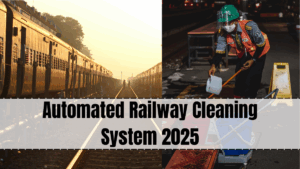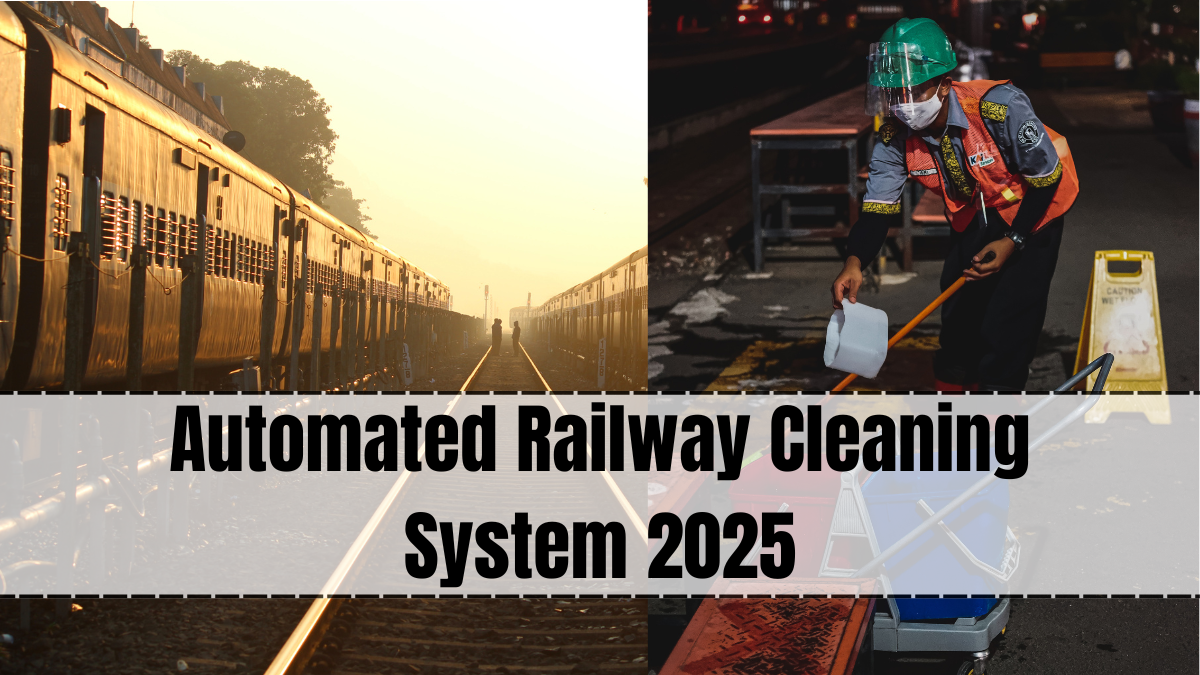In 2025, Indian Railways has embraced cutting-edge technology to transform cleanliness and hygiene standards across its vast network. The Automated Railway Cleaning System now uses AI-driven cleaning robots to maintain stations, platforms, and train coaches. This modern initiative aims to provide passengers with cleaner travel environments while reducing manual workload and ensuring consistent sanitation levels.
With over 23 million passengers traveling daily, the railway network has long struggled with litter, waste management, and hygiene challenges. The new system addresses these concerns using railway tech innovations designed for efficiency, safety, and sustainability.

How the Automated Railway Cleaning System Works
The AI-powered cleaning robots operate with minimal human intervention, using advanced sensors, cameras, and machine learning algorithms to detect and remove waste. Key functions include:
-
Floor Sweeping & Mopping – Automated machines clean station floors and platforms.
-
Waste Collection – Robotic units collect and segregate dry and wet waste.
-
Coach Cleaning – Compact robots sanitize seats, floors, and windows in train coaches.
-
Toilet Maintenance – AI-enabled cleaning ensures restrooms remain hygienic throughout the journey.
-
Air Quality Monitoring – Integrated sensors detect dust and pollutants, activating air purifiers when needed.
These functions make railway tech cleaning operations more thorough and time-efficient.
Key Benefits of AI-Driven Cleaning Robots
The Automated Railway Cleaning System 2025 offers multiple advantages:
-
Consistent Hygiene – Standardized cleaning ensures no spot is overlooked.
-
Reduced Labor Strain – Robots handle repetitive and hazardous cleaning tasks.
-
Faster Turnaround – Coaches are cleaned quicker, reducing downtime between trips.
-
Eco-Friendly Operations – Robots use water-optimizing systems to reduce wastage.
-
Data-Driven Maintenance – AI collects cleanliness data to improve future operations.
These benefits enhance passenger experience while improving operational efficiency.
Integration with Indian Railways’ Modernization Plan
The launch of cleaning robots is part of the broader Indian Railways modernization strategy, which includes:
-
Smart Stations – Equipped with digital displays, automated ticketing, and robotic cleaning.
-
Green Initiatives – Waste-to-energy plants for processing collected waste.
-
Digital Maintenance Logs – Real-time cleanliness tracking through mobile apps.
This integration ensures hygiene is prioritized alongside speed, safety, and passenger comfort.
Impact on Passenger Experience
For travelers, the Automated Railway Cleaning System means:
-
Cleaner Coaches – No litter on seats, floors, or windows.
-
Hygienic Toilets – Reduced odor and better sanitation during long journeys.
-
Safer Environments – Less manual cleaning reduces human exposure to harmful waste.
-
Higher Satisfaction – Improved cleanliness leads to better passenger feedback scores.
This focus on hygiene also supports tourism and encourages more people to choose train travel.
Challenges in Implementation
Despite its benefits, deploying AI cleaning robots on such a large scale faces challenges:
-
High Initial Costs – Procuring and installing advanced equipment is expensive.
-
Training Staff – Railway workers need to learn to operate and maintain new machines.
-
Maintenance Requirements – Robots require regular servicing and software updates.
-
Infrastructure Gaps – Smaller stations may lack proper docking and charging facilities.
The government is working to address these issues by rolling out the system in phases.
The Future of Automated Railway Cleaning in India
Looking ahead, railway tech will likely include:
-
Fully Autonomous Maintenance Trains – Dedicated trains equipped with robotic cleaning units.
-
AI-Powered Predictive Cleaning – Systems that schedule cleanings based on passenger flow data.
-
Integration with Waste Recycling Plants – Creating a zero-waste railway ecosystem.
-
Advanced Disinfection Technologies – UV-based cleaning for viral and bacterial control.
With continuous upgrades, the Automated Railway Cleaning System is set to become a global model for transport hygiene.
Final Thoughts
The Automated Railway Cleaning System 2025 marks a milestone in Indian Railways’ journey toward modernization and passenger comfort. By incorporating AI cleaning robots, the network is not only improving hygiene but also setting new standards for operational efficiency.
As more stations and trains adopt this technology, passengers can look forward to cleaner, safer, and more enjoyable journeys across India.
FAQs
What is the Automated Railway Cleaning System 2025?
It’s an AI-powered cleaning initiative that uses robots to maintain hygiene in stations and train coaches.
How do the cleaning robots operate?
They use sensors, cameras, and AI algorithms to detect waste, clean floors, sanitize surfaces, and manage toilets.
Will this system replace human workers?
No, it will assist staff by handling repetitive and hazardous cleaning tasks, allowing them to focus on more complex duties.
Is the system available in all stations?
Currently, it is being implemented in major stations, with gradual expansion planned for smaller ones.
Are these cleaning robots eco-friendly?
Yes, they are designed to use less water, segregate waste, and operate with minimal energy consumption.
Click here to know more.
